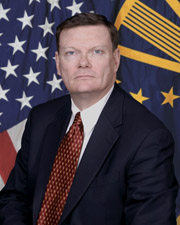
DoD losing ground on IT employee retention battle
The Defense Department’s top tech official said his top worry is the retention and recruitment of talented employees as pay and benefits make it more enticing to...
The Defense Department’s top tech official said his biggest concern is the retention and recruitment of talented employees as pay and benefits make it more enticing to work for private companies.

“The challenge I think we are going to have in IT may not be exactly in the budget, it’s going to be the retention of the IT workforce,” DoD Chief Information Officer Terry Halvorsen told the House Armed Services Emerging Threats and Capacities Subcommittee March 22. “That’s going to come down to an economic decision. I happened to be in [Silicon] Valley last week and Google announced they are raising the pay for cybersecurity by another 20 percent. That’s going to keep impacting our ability to attract talent. … What keeps me up at night? That’s probably the answer.”
In recent years DoD and other government agencies have had problems hiring young, tech savvy employees. In 2013, only 7 percent of government employees were under 30. That’s compared to about 19 percent in 1973, an Office of Personnel Management study stated.
That doesn’t bode well for DoD, which is trying to amp up its technological capabilities and increase its cyber workforce.
Halvorsen told lawmakers he could use some new authorities to help with recruiting and retaining talent.
Halvorsen said he will eventually need legislation that changes the rule sets of how government can interact with industry.
“We really want them to come in and sit in a position for a year, being able to execute some decisions within the department and then go back to industry,” Halvorsen said. “Just like I think there’s a marketspace today for us to have some of our civilian employees go to industry and industry would like to have them. I think we’ll need to tweak some of the legislation so that can happen more often.”
Frank Kendall, the Defense Undersecretary for Acquisition, Technology and Logistics, said something similar earlier this month.
“It’s too hard to come in [to government] and come back out,” Kendall said. “We used to have very, very talented, the best and brightest people in government. They’d come in from industry for a few years, they’d make a contribution to their country and they’d go back and nobody assumed they were a crook. I think we’ve gone too far trying to protect ourselves from the rare person who is really going to do wrong and we deny ourselves an enormous amount of talent.”
Those laws were originally put into place to keep corruption at bay. Without the laws, government officials may give breaks or make decisions in favor of a company that promises them a job. Other scenarios involve former government employees using their connections to give companies an unfair advantage.
Rep. Jim Langevin (D-R.I), the ranking member on the House Armed Services Emerging Threats and Capacities Subcommittee, told Federal News Radio after the hearing he would be looking to the department for what it needs.
“There are barriers and things we are going to have to work out and there are challenges in accomplishing that,” Langevin said about easing the transition between the public and private sectors.
But, recruitment and retention aren’t the only areas where DoD is hurting when it comes to preparing for the future.
The National Guard said it has a training backlog for service members wanting to join cyber units.
The National Guard plans to have 30 cyber units that will be stationed in at least 30 states by fiscal 2019.
Federal news Radio contacted the National Guard for the exact details of its backlog, but did not receive a response in time for the publication of this article.
But, Sen. Jerry Moran (R-Kan.) did have an example of the lack of available training during a March 16 Senate Appropriations Defense Subcommittee hearing.
“There is a sufficient number of people that want to fill those slots, but an insufficient number of people who are training those individuals to do so,” Moran said. “One of the new cyber squadrons at McConnell [Air Force Base in Kansas] has 42 vacancies. I don’t think this is because we can’t find the individuals who want to fill those 42 vacancies. It’s because we only have three of those folks who are in a position to receive the training this fiscal year.”
Realistic timelines for completing NBIB
While Halvorsen worried about the IT talent, lawmakers said they were afraid DoD had not been given realistic timelines to complete the National Background Investigations Bureau (NBIB).
DoD was tasked with the design and execution of NBIB’s IT systems.
The new agency will absorb the Federal Investigative Services, the organization that currently conducts about 95 percent of federal background checks and was created in the wake of the OPM cyber hacks. The President’s budget requests $95 million in fiscal 2017 year for NBIB.
Langevin said he had concerns DoD was assuming all responsibilities for NBIB IT performance, while the decision-making authority may be shared.
Halvorsen said he had qualms too.
“I’d be foolish to say there’s not some concern on the DoD’s part about how this is going to work and what I would assure you is from a standpoint of the build we are going to get the requirements from the group that’s looking at how we are going to redo the whole investigation process. When I have those requirements, and that group starts next week, we will build a system that supports those requirements that also ensures security. If at any time I think that’s not happening I will be the first to let you know,” Halvorsen said to the subcommittee.
Copyright © 2025 Federal News Network. All rights reserved. This website is not intended for users located within the European Economic Area.
Scott Maucione is a defense reporter for Federal News Network and reports on human capital, workforce and the Defense Department at-large.
Follow @smaucioneWFED





